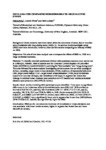META-ANALYSIS COMPARING BIORESORBABLE VS. DRUG-ELUTING STENTS
| dc.contributor.author | King, N | |
| dc.contributor.author | Wood, C | |
| dc.contributor.author | Smart, NA | |
| dc.date.accessioned | 2018-03-20T11:21:06Z | |
| dc.date.available | 2018-03-20T11:21:06Z | |
| dc.date.issued | 2017 | |
| dc.identifier.issn | 0008-6312 | |
| dc.identifier.issn | 1421-9751 | |
| dc.identifier.uri | http://hdl.handle.net/10026.1/11116 | |
| dc.description | File replaced (incorrect version) on 22/9/2022 by KT (LDS). | |
| dc.description.abstract |
Background: Some concerns have been raised about the occurrence of acute, late or very late stent thrombosis with drug eluting stents (DES) [1]. To address this bioresorbable stents (BRS) have been introduced; however, there are few studies comparing the efficacy of BRS vs. DES. Objectives: The aim of this meta-analysis was to compare the effects of BRS vs. DES on a range of clinical outcomes. Methods: To identify potential randomised clinical trials systematic searches were carried out in EMBASE, PubMed, Web of Science and the Cochrane Central Registry of Controlled Trials (CENTRAL) (until 24/02/2017) searching for “bioresorbable” and “drug eluting stent”. This was followed by a meta-analysis investigating device success (no use of an unassigned device), mortality, target lesion revascularisation (TLR), incidence of myocardial infarction (MI), target lesion failure (TLF), target vessel revascularisation (TVR), early thrombosis (equal to or less than 30 days), late thrombosis (>30 days), in segment late lumen loss (change in minimal lumen diameter post-procedure to 6-13 months) and minimum luminal diameter post-procedure (MLDPP) (in device). Results: Seven studies involving 4914 participants were identified. There were no significant differences in the incidences of early thrombosis (odds ratio (OR) 1.67 [95% confidence interval (CI) 0.79-3.54, p=0.18]), late thrombosis (OR 1.11 [95% CI 0.51-2.42, p=0.8]), mortality, MI, TLR, TLF, and TVR for BRS vs. DES. Device success (OR 0.16 [95% CI 0.08-0.31, p<0.00001]) and MLDPP (in device) (mean difference (MD) -0.11mm [95% CI - 0.14-0.07, p<00001]) were significantly lower and in segment late lumen loss (MD 0.04mm [95% CI 0.00-0.07, p=0.04) was significantly higher for BRS. Conclusions: BRS use did not reduce the incidence of thrombosis or revascularisation and was associated with lower device success, higher in segment late lumen loss and lower MLDPP (in device). | |
| dc.format.extent | 276-276 | |
| dc.language.iso | en | |
| dc.title | META-ANALYSIS COMPARING BIORESORBABLE VS. DRUG-ELUTING STENTS | |
| dc.type | conference | |
| dc.type | Meeting Abstract | |
| plymouth.author-url | https://www.webofscience.com/api/gateway?GWVersion=2&SrcApp=PARTNER_APP&SrcAuth=LinksAMR&KeyUT=WOS:000405743600263&DestLinkType=FullRecord&DestApp=ALL_WOS&UsrCustomerID=11bb513d99f797142bcfeffcc58ea008 | |
| plymouth.volume | 137 | |
| plymouth.publication-status | Published | |
| plymouth.journal | CARDIOLOGY | |
| plymouth.organisational-group | /Plymouth | |
| plymouth.organisational-group | /Plymouth/Faculty of Health | |
| plymouth.organisational-group | /Plymouth/REF 2021 Researchers by UoA | |
| plymouth.organisational-group | /Plymouth/REF 2021 Researchers by UoA/UoA03 Allied Health Professions, Dentistry, Nursing and Pharmacy | |
| plymouth.organisational-group | /Plymouth/Users by role | |
| plymouth.organisational-group | /Plymouth/Users by role/Academics | |
| dc.identifier.eissn | 1421-9751 | |
| dc.rights.embargoperiod | Not known | |
| rioxxterms.licenseref.uri | http://www.rioxx.net/licenses/all-rights-reserved | |
| rioxxterms.type | Conference Paper/Proceeding/Abstract |


